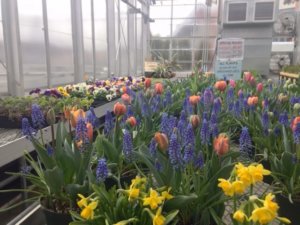Who’s in the garden?
It seems pretty crowded out there if you’re familiar with all the popular cultivars in commerce today. Ever wondered who all those people named in plant circles really are? For instance, “Robert” of Herb Robert geranium? “Miss Willmott” of ‘Miss Willmott’s Ghost’? “Joan Senior” of daylily fame? “Nora Barlow” Colombine?
 Usually, the names attributed are honorifics. Some are relatives or spouses of the namer and some honor the finder or identifier. When John Tradescant the younger was touring the young country that became the United States, he found a beautiful tree in bloom in Georgia. He knew it was new to botanical circles and named it after an illustrious American, Ben Franklin. The Franklinia tree is now extinct in the wild, but fortunately some material was saved to propagate it and all current examples are derived from that one plant.
Usually, the names attributed are honorifics. Some are relatives or spouses of the namer and some honor the finder or identifier. When John Tradescant the younger was touring the young country that became the United States, he found a beautiful tree in bloom in Georgia. He knew it was new to botanical circles and named it after an illustrious American, Ben Franklin. The Franklinia tree is now extinct in the wild, but fortunately some material was saved to propagate it and all current examples are derived from that one plant.
Aqueligia “Nora Barlow” is an unusual rosy columbine with ruffly petals. Nora was the granddaughter of Charles Darwin. It was she who championed his name and efforts after his death.
Our 16th President, Abraham Lincoln, has not only a blue lilac named after him, but a popular tea rose. Speaking of roses, you’ll find many named after celebrities in the arts as well as popular culture. Some well-loved are Beverly Sills, Julia Child, Gertrude Jekyll and a longtime favorite, Queen Elizabeth II.
Fuchsia was named after Leonhart Fuchs, a physician and herbalist of renown, who also made beautiful woodcuts of many plants but, interestingly, never saw a fuchsia. Sir Joseph Banks accompanied Captain James Cook on his voyage to the Pacific and preserved many specimens. There is a small yellow rose named after him (Banksia) as well as a protea (National Flower of South Africa). He introduced many plants and ventured on several other journeys at his own expense. He served as the leader of the Royal Horticultural Society and well as other scientific groups. His efforts form the base of collections in the British Museum and British Museum of Natural History.
Miss Ellen Willmott was an eccentric heiress who used her considerable fortune to buy plants and gardens to put them in. One story that goes round about Miss Willmott is her love for Erygium giganteum, a silvery, prickly bloom. She carried seeds for it in her pockets. If a garden she visited lacked it, she sprinkled the seeds here and there. Since it mysteriously popped up where it hadn’t been planted, it became known as “Miss Willmott’s Ghost.”
The Douglas fir was named after David Douglas, a Scottsman who traveled extensively in the Pacific Northwest and introduced many native western plants to England and Scotland. He came to an ignominious death after being gored by a bull on the Hawaiian Islands.
Lately you may have noticed that some of the names you were familiar with have changed. As frustrating as this is to the gardener, the new appellations are generally more accurate because of our ability to study their DNA. Identifying plants has become a much more exact science because of this.
We’ve hardly touched the surface of characters inhabiting our gardens. I hope you’ve been enlightened and might be encouraged to learn more. Some good resources are: Stearns Dictionary of Plant Names for Gardeners, Who Does Your Garden Grow by Alex Pankhurst, and The Naming of Names by Anna Pavord.

